Alaca Höyük
Alacahöyük or Alaca Höyük (sometimes also spelled as Alacahüyük, Aladja-Hoyuk, Euyuk, or Evuk) is the site of a Neolithic and Hittite settlement and is an important archaeological site. It is situated in Alaca, Çorum Province, Turkey, northeast of Boğazkale (formerly and more familiarly Boğazköy), where the ancient capital city Hattusa of the Hittite Empire was situated. Its Hittite name is unknown: connections with Arinna, Tawiniya, and Zippalanda have all been suggested.[1] [2]
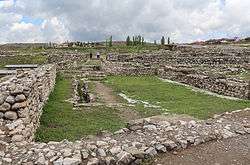 Alaca Höyük | |
 Shown within Turkey | |
| Location | Çorum Province, Turkey |
|---|---|
| Region | Anatolia |
| Coordinates | 40°14′04″N 34°41′44″E |
| Type | Settlement |
| Site notes | |
| Condition | In ruins |
History
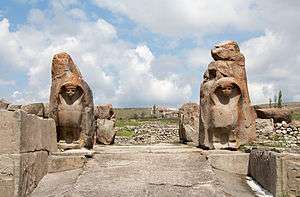
The mound (Turkish höyük) at Alacahöyük was a scene of settlement in a continuous sequence of development from the Chalcolithic Age, when earliest copper tools appeared alongside the use of stone tools.
Bronze Age
During the Early Bronze Age, the mound was the center of a flourishing Hattian culture. It has been continuously occupied ever since, until today's modern settlement in the form of a small village. The standing and distinguishing remains at Alacahöyük, however, such as the "Sphinx Gate", date from the Hittite period that followed the Hatti, from the fourteenth century BC.
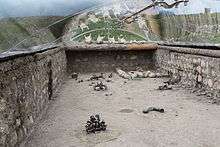
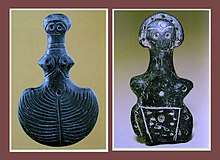
.jpg)
.jpg)
Thirteen shaft-grave "Royal Tombs" (EBII, c. 2350–2150 BC) in Alacahöyük contained the dead in fetal position facing south. They were richly adorned with gold fibulae, diadems, and belt buckles and repoussé gold-leaf figures.
According to Trevor Bryce:
″There is a theory that the occupants of the tombs were not from the native Hattian population of central Anatolia, but were Kurgan immigrants from the region of Maikop in southern Russia, who spoke an Indo-European language and perhaps became rulers of the local Hattian population.″[3]
However, Hittitologist J.G. Macqueen suggested that these tombs, while constructed by an Indo-European people, were not constructed by Anatolian-speakers, such as Hittites:
"[...] there is no sign of any spread of this kurgan culture further south in Anatolia, so it cannot be linked to the spread of Hittite, to say nothing of Palaic or Luwian. The language of the rulers who were buried in the Alaca tombs, although probably Indo-European, was almost certainly not Proto-Hittite."[4]
Many of the artefacts discovered at Alacahöyük, including magnificent Hattian gold and bronze objects found in the Royal Tombs, are housed today in the Museum of Anatolian Civilizations in Ankara. Among these artefacts are gold and electrum standing cups and other vessels. The most unusual are the Alaca Höyük bronze standards; bulls or stags on pedestals whose purpose remains the subject of debate. The standards are cast in copper, many in the form of flat circles, half-circles or squares that are filled with an openwork network of cross bars, central crosses, and swastikas. Leonard Woolley[5] found that the Royal Tombs "seem to belong to the end of a period, as marked by a stratum of destruction and the burning of the citadel. The culture which the tomb objects illustrate does not continue into the next historical phase, that of Kültepe". Modern assessment[6] finds that the site continued as a flourishing community to the end of the Late Bronze Age. There was also a sizable occupation in Phrygian times.
Dams
A dam, dating from 1240 BC, was announced to be reopened for use on September 23, 2006. The dam was ordered by King Tudhaliya IV in the name of the goddess Hebat. According to ancient Hittite tablets, a drought struck Anatolia in 1200 BC, prompting the King to import wheat from Egypt so that his land would avoid famine. Following this, the king ordered numerous dams to be built in central Anatolia, all but one of them becoming non-functional over time. The one in Alacahöyük has survived because the water source is located inside the dam's reservoir.
Archaeology
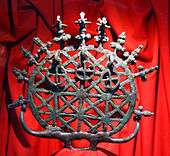
In 1907, the Ottoman archaeologist Theodor Makridi Bey carried out brief explorations here for two weeks. [7] In the 1910s, German teams discovered royal tombs dating to the third millennium BC, as well as a Hittite town of the second millennium BC. The impressive sphinx gate surrounded by stone reliefs marked its entrance. [8] The town was heavily fortified with walls and towers due to the frequent raids of the Kaska people living in the mountainous region to the north. Excavations by the Turkish archaeologists Remzi Oğuz Arık and Hamit Koşay resumed in 1935 under the personal instructions of Atatürk who contributed from his own budget. [9][10] The work, which continued until 1970, revealed considerable local wealth and achievement even before the time of the Hittites, with the earliest occupation dating from the 4th millennium BC. Tombs of the 3rd millennium BC feature metal vessels, jewelry, weapons, and pole finials of bulls, stags, as well as abstract forms often interpreted as solar symbols. Excavation at the site resumed in 1994, and is now directed by Dr. Aykut Çınaroğlu.
See also
- Alishar Hüyük
- Cities of the ancient Near East
Notes
- Gorny, Ronald L. "Zippalanda and Ankuwa: The Geography of Central Anatolia in the Second Millennium B. C." Journal of the American Oriental Society. Vol. 117, no. 3, pp. 549-557 (1997).
- Popko, Maciej. "Zippalanda and Ankuwa Once More." Journal of the American Oriental Society. Vol. 120, no. 3, pp. 445-448 (2000).
- Trevor Bryce, The Routledge Handbook of the Peoples and Places of Ancient Western Asia: The Near East from the Early Bronze Age to the Fall of the Persian Empire. Routledge, 2013 ISBN 1134159080 p. 21
- Macqueen, J. G. The Hittites, and Their Contemporaries in Asia Minor, revised and enlarged, Ancient Peoples and Places series, Thames and Hudson, 1996 ISBN 0-500-02108-2 p. 32
- Woolley 1961
- Trevor Bryce, The Kingdom of the Hittites rev. ed., Oxford University Press, 2006, ISBN 0-19-928132-7
- Theodor Makrid Bey, La porte des sphinx a Euyuk Fouilles du Musee Imperial Ottoman, Mitteilungen der Vorderasiatisch-Agyp-tischen Gesellschaft, vol. 13, 1908
- Robert L. Alexander, A Great Queen on the Sphinx Piers at Alaca Hüyük, Anatolian Studies, vol. 39, pp. 151-158, 1989
- H. Z. Kosay, Ausgrabungen von Alaca Höyük: ein Vorbericht über die im Auftrage der Türkischen Geschichts kommission im Sommer 1936 durchgeführten Forschungen und Entdeckungen, TTKY, vol. 2a, 1944
- Hâmit Z Kosay and Mahmut Akok, Alaca Höyük excavations : preliminary report on research and discoveries 1963-1967, Türk tarih Kurumu yayunlarindan. 5. ser, sa. 28, 1973
References
- Remzi Oguz Arik, Les Fouilles d'Alaca Höyük: Entreprises par la société d'histoire turque. Rapport preliminaire sur les travaux en 1935, Publications de la Société Turque, 1937
- Ayse Gursan-Salzmann, Alaca Hoyuk: A reassessment of the excavation and sequence of the Early Bronze Age settlement, University of Pennsylvania, 1992
- Hamit Z. Koşay and Mahmut Akok, The Pottery of Alaca Höyük, American Journal of Archaeology, vol. 51, no. 2, pp. 152–157, 1947
- The Art of The Middle East, including Persia, Mesopotamia and Palestine - Woolley
- M. J. Mellink, Observations on the Sculptures of Alaca Hoyuk, Anatolia, vol. 14, pp. 15–27, 1970
- Ahmet Unal, The Textual Illustration of the Jester Scene on the Sculptures of Alaca Höyük, Anatolian Studies, vol. 44, pp. 207–218, 1994
- O.R Gurney, The Ladder-Men at Alaca Höyük, Anatolia Studies, vol. 44, pp. 219–220, 1994
- Piotr Taracha, The Iconographic Program of the Sculptures of Alacahöyük, Journal of Ancient Near Eastern Religions, vol. 11, iss. 2, pp. 132–147, 2011
- Chisholm, Hugh, ed. (1911). . Encyclopædia Britannica. 9 (11th ed.). Cambridge University Press. pp. 958–959.
External links
| Wikimedia Commons has media related to Alacahöyük. |